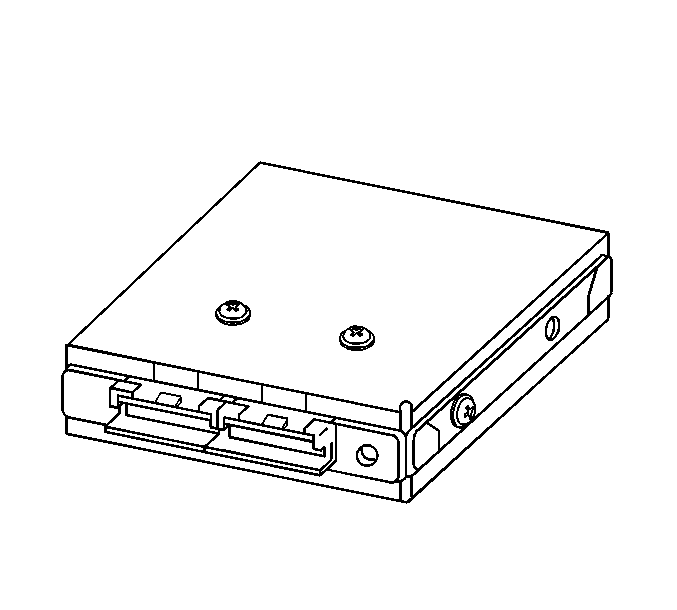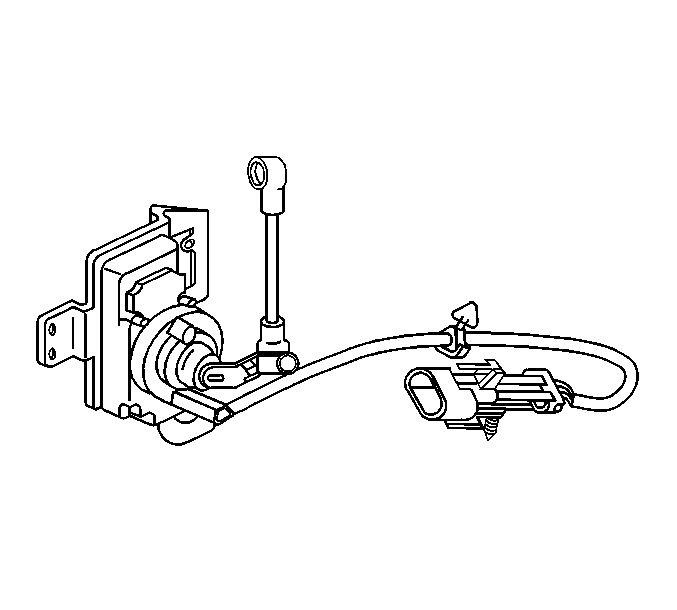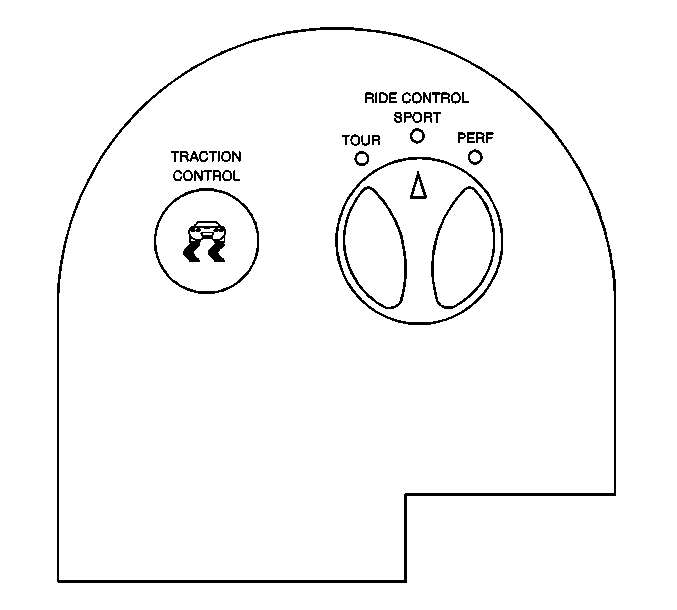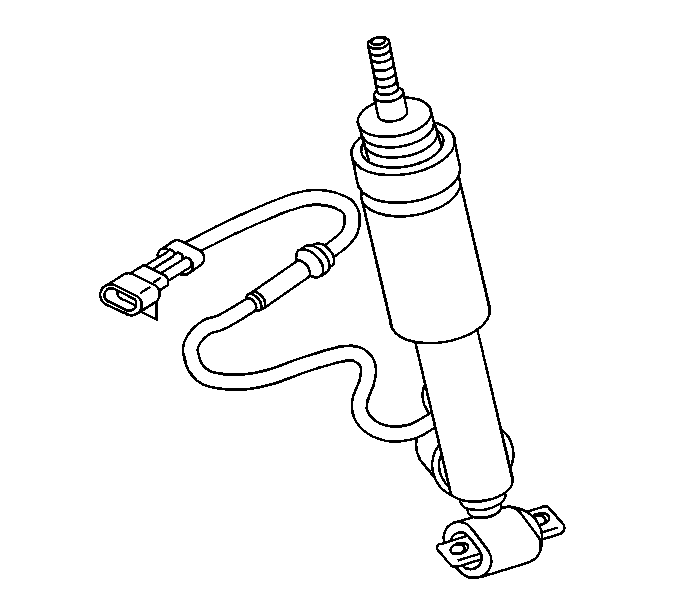Real Time Damping Description
The Real Time Damping (RTD) system independently controls a solenoid in each of the four shock absorbers in order to control the vehicle ride characteristics. The RTD system is capable of making these changes within milliseconds. The RTD system consists of the following major components:
| • | The electronic suspension (ESC) module |
| • | The front/rear position sensors |
| • | The ride control switch |
| • | The front/rear adjustable shock absorbers |
| • | The shock absorber electrical solenoids, which are integrated within the shock absorbers. |
The RTD system has the following 3 shock damping control settings:
| • | TOUR -- Provides a smooth, soft ride |
| • | SPORT -- Provides more feel/response to road conditions |
| • | PERF -- Provides tight, firm ride and precise response to road conditions |
The ESC controls the damping mode selection according to the following factors:
| • | The vehicle speed |
| • | The chassis pitch input |
| • | The steering position |
| • | The body to wheel displacement |
| • | The ride control switch position |
The ESC module evaluates these inputs in order to separately control the solenoid valve position in each of the shock absorbers, providing an enhanced ride and comfort level over the widest possible range of operating conditions.
Electronic Suspension Control Module

The ESC module provides electronic control logic and output drive for each shock absorber solenoid. The ESC module makes decisions due to road and driving conditions based on various inputs. The ESC module receives input information by sensors that are directly connected to the ESC module or by other systems through the serial data line.
The ESC module uses these inputs in order to independently control the shock absorbers at each corner. The ESC module is located in the LH rear storage.
Electronic Suspension Position Sensors

The position sensors provide the ESC module with the body to wheel displacement input. The ESC module uses this and other inputs in order to control the position of the shock absorber solenoids. If any body or wheel motion is detected, the ESC module will determine how soft or firm each shock absorber should be to provide the best ride. The position sensors are mounted at each corner of the vehicle between the control arm and the body.
Electronic Suspension Ride Control Switch

The ride control switch allows the driver to manually select a desired shock absorber damping control setting. The switch has the following three positions:
| • | TOUR |
| • | SPORT |
| • | PERF |
The ride control switch provides specific resistance values to the ESC module in order to allow for identification of the selected settings. The switch is located on the top of the center floor console.
Shock Absorber or Strut

The RTD shock absorbers are pressurized nitrogen gas type which provide damping by forcing hydraulic fluid through internal orifices to resist suspension movement. The RTD shock absorber has the capability of providing multiple modes or values of damping forces, in both compression and rebound direction. The damping forces are achieved by redirecting the flow of hydraulic fluid by using a solenoid valve. The solenoid valve varies the amount of fluid allowed to bypass by pulse width modulating the solenoid. The solenoid valve is an integral part of the shock absorber and is not serviceable separately.
The softer modes are accomplished by pulse width modulating the solenoid valve OFF more than ON causing hydraulic oil to by-pass the main shock absorber valving. A more firm ride is accomplished by pulse width the solenoid valve ON more than OFF causing the hydraulic oil to flow through the main shock absorber valving. The RTD solenoid valve is a normally open design and when OFF will be in the full soft position.
Real Time Damping Operation
The RTD system uses the information from other systems in order to execute certain functions.
The RTD system does not have a malfunction indicator lamp, but instead uses the Instrument Panel Cluster (IPC) for the display functions. When the RTD system detects a malfunction that sets a DTC, the RTD system sends a message on the serial data line directly or through the PCM to the IPC, which will display one of the following messages:
| • | SHOCKS INOPERATIVE |
| • | SERVICE RIDE CONTROL |
| • | MAXIMUM SPEED |
The SHOCKS INOPERATIVE message will only be displayed if the RTD system detects a malfunction that sets a DTC and causes the RTD system to disable all four shock absorbers. The RTD system will send a message on the serial data line to the IPC to display this message.
The SERVICE RIDE CONTROL message will only be displayed if the RTD system detects any malfunction that sets a DTC. The RTD system will send a message on the serial data line to the IPC to display this message.
The MAXIMUM SPEED message will only be displayed if the RTD system detects a malfunction that sets a DTC and causes the RTD system to disable all four shock absorbers. The RTD system will send a message on the serial data line to the PCM indicating that all four shock absorbers were disabled. The PCM then sends a message to the IPC to display this message.
The ESC module has the ability to store Diagnostic Trouble Codes (DTCs) as current or history codes. Most RTD system malfunctions will display a message in the IPC and set a DTC. The message will remain ON until the RESET button is pressed on the Driver Information Center (DIC). As long as the DTC is current, the message will be displayed after every ignition cycle and the RESET button must be pressed to bypass the message.
The RTD system uses an ignition cycling diagnostic approach in order to reduce the occurrence of false or intermittent DTCs that do not affect the functionality of the RTD system. This allows for the fail-soft actions to be taken whenever a malfunction condition is current, but requires the malfunction to be current for a certain number of ignition cycles before the corresponding malfunction code and message will be stored or displayed.
If the RTD detects a malfunction, the RTD system defaults with a fail-soft action. A fail-soft action refers to any specific action the RTD system takes in order to compensate for a detected malfunction. A typical RTD fail-soft action would be if the RTD system detects a malfunction with the ride control switch, the RTD system will ignore this input and fail-soft to the SPORT ride setting.
